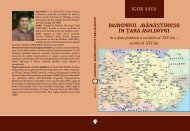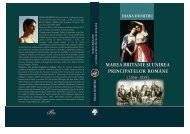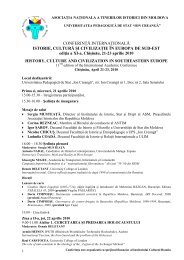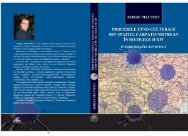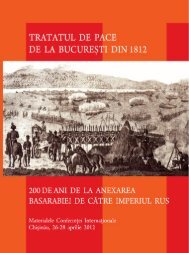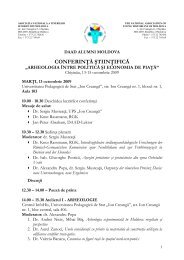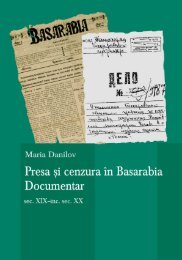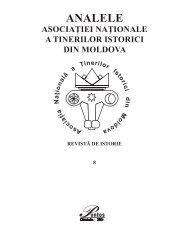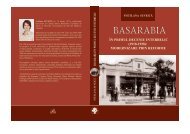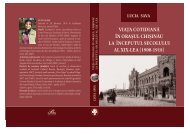Document PDF - Asociatia Tinerilor Istorici din Moldova
Document PDF - Asociatia Tinerilor Istorici din Moldova
Document PDF - Asociatia Tinerilor Istorici din Moldova
Erfolgreiche ePaper selbst erstellen
Machen Sie aus Ihren PDF Publikationen ein blätterbares Flipbook mit unserer einzigartigen Google optimierten e-Paper Software.
FINANCING THE UNIVERSITY STUDIES IN THE EARLY MODERN TIMES<br />
BASED ON THE EXAMPLE OF STUDENTS FROM KOŠICE<br />
IN PRESENT-DAY EASTERN SLOVAKIA 1<br />
Iulia CAPROŞ<br />
Financing university studies: general facts<br />
The question of fi nancing university studies has piqued the interest of a number of scholars<br />
in the fi eld of university history 2 . Beside the direct fi nancial support provided by parents<br />
or relatives and wages from different jobs, the following fi nancing possibilities have been presented<br />
and commented upon: scholarships based on colleges or bursas, ecclesiastical or<br />
princely benefi ces, scholarship foundations of different kinds, testamentary donations, and<br />
fi nancial support obtained from different institutions such as monastic centers or the administration<br />
of towns. The fi rst colleges, meant by their founders to be charitable institutions offering<br />
accomodation for a number of poor students, initially originated in Paris, Oxford, and<br />
Cambridge, and later spread to other university towns. However, this type of support hardly<br />
covered more than the cost of lodging and additional sponsorship was necessary. At the same<br />
time, the number of students who could benefi t from it was rather limited. 3 Another possibility<br />
for fi n<strong>din</strong>g fi nancial support for studies were the ecclesiastical benefi ces offered by the pope,<br />
local bishops or other patrons. However, the amount of research carried out on this issue is not<br />
suffi cient to permit for general conclusions to be drawn concerning the numbers of students<br />
and the conditions that made these benefi ces accessible to them. A further possibility was<br />
what Paul Trio and others refer to as ‘fl ying grants’ (bursae volantes), by which a founder, in<br />
a testamentary disposition, provided one or more students with a certain long-term fi nancial<br />
support (usually paid on a yearly basis) and entrusted the administration of this type of stipend<br />
foundation to an individual or an institution, for example to the town council. This type of grant<br />
usually demanded several conditions to be met by the grantee and sometimes even specified<br />
the institution or the faculty for the promoted study 4 .<br />
Stipend foundations (Studienstiftungen) already appear in European towns in the middle<br />
of the fourteenth century, however, a real increase in their numbers took place in the second half<br />
of the fi fteenth century. 5 Another form of fi nancial aid for study expenses was patronage, which<br />
represented a a temporary bequest of money or other goods (clothes or books) to university<br />
students. 6 Rich individual patrons (kings, princes, or individuals of lesser rank) or institutions<br />
have been identifi ed as patrons. These included urban administration, religious institutions, or<br />
student-confraternities, the latter established exclusively for the purpose of offering fi nancial<br />
support to students. Urban councils in German towns already had the practice of fi nancing the<br />
university studies of their inhabitants beginning with the fi fteenth century when the number of<br />
sponsored students is still low but the tendency is developing continuously. 7 While before that<br />
1<br />
This article is based on the material provided in the chapter four of my doctoral thesis, defended at the Central<br />
European University from Budapest, Hungary, in 2010.<br />
2<br />
TRIO 1984, 1-24 with further bibliographical references.<br />
3<br />
SCHWINGES 1986, 527-564.<br />
4<br />
TRIO 1984, 4ff.<br />
5<br />
WRIEDT 1993, 35ff.<br />
6<br />
TRIO 1984, 10ff.<br />
7<br />
For the example of the town of Braunschweig see the well documented study by Martin Kintzinger: KINTZ-<br />
INGER 1990, 466f.<br />
– 204 –



